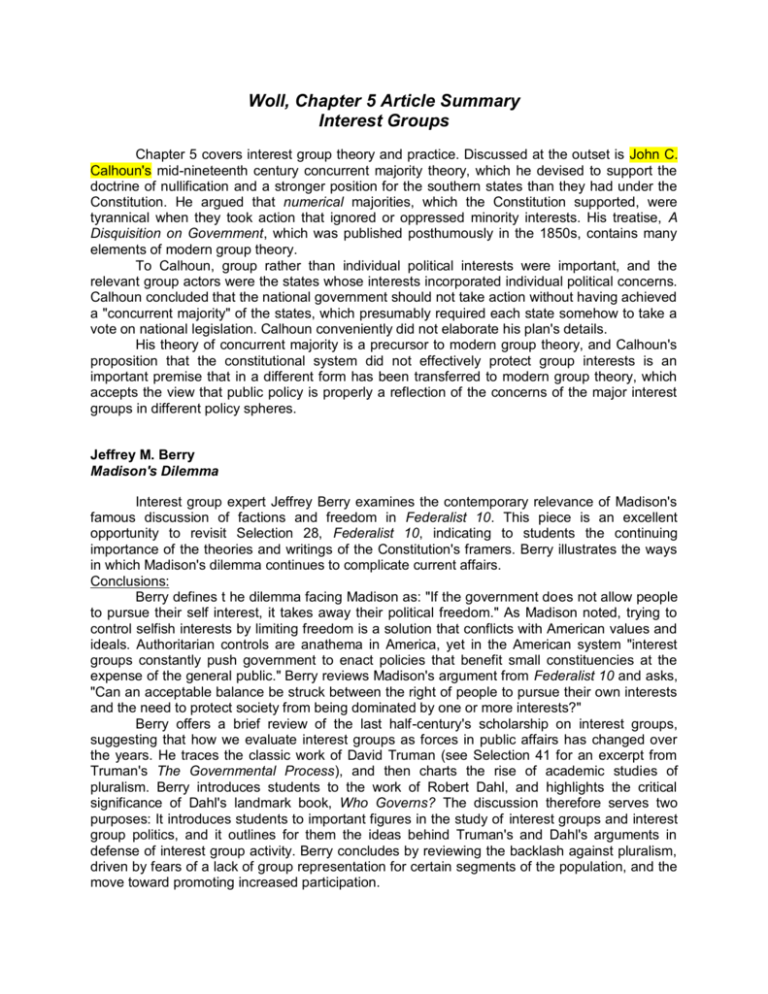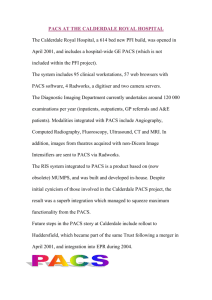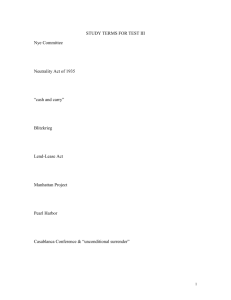Woll, Chapter 5 Article Summary Interest Groups - Jb-hdnp
advertisement

Woll, Chapter 5 Article Summary Interest Groups Chapter 5 covers interest group theory and practice. Discussed at the outset is John C. Calhoun's mid-nineteenth century concurrent majority theory, which he devised to support the doctrine of nullification and a stronger position for the southern states than they had under the Constitution. He argued that numerical majorities, which the Constitution supported, were tyrannical when they took action that ignored or oppressed minority interests. His treatise, A Disquisition on Government, which was published posthumously in the 1850s, contains many elements of modern group theory. To Calhoun, group rather than individual political interests were important, and the relevant group actors were the states whose interests incorporated individual political concerns. Calhoun concluded that the national government should not take action without having achieved a "concurrent majority" of the states, which presumably required each state somehow to take a vote on national legislation. Calhoun conveniently did not elaborate his plan's details. His theory of concurrent majority is a precursor to modern group theory, and Calhoun's proposition that the constitutional system did not effectively protect group interests is an important premise that in a different form has been transferred to modern group theory, which accepts the view that public policy is properly a reflection of the concerns of the major interest groups in different policy spheres. Jeffrey M. Berry Madison's Dilemma Interest group expert Jeffrey Berry examines the contemporary relevance of Madison's famous discussion of factions and freedom in Federalist 10. This piece is an excellent opportunity to revisit Selection 28, Federalist 10, indicating to students the continuing importance of the theories and writings of the Constitution's framers. Berry illustrates the ways in which Madison's dilemma continues to complicate current affairs. Conclusions: Berry defines t he dilemma facing Madison as: "If the government does not allow people to pursue their self interest, it takes away their political freedom." As Madison noted, trying to control selfish interests by limiting freedom is a solution that conflicts with American values and ideals. Authoritarian controls are anathema in America, yet in the American system "interest groups constantly push government to enact policies that benefit small constituencies at the expense of the general public." Berry reviews Madison's argument from Federalist 10 and asks, "Can an acceptable balance be struck between the right of people to pursue their own interests and the need to protect society from being dominated by one or more interests?" Berry offers a brief review of the last half-century's scholarship on interest groups, suggesting that how we evaluate interest groups as forces in public affairs has changed over the years. He traces the classic work of David Truman (see Selection 41 for an excerpt from Truman's The Governmental Process), and then charts the rise of academic studies of pluralism. Berry introduces students to the work of Robert Dahl, and highlights the critical significance of Dahl's landmark book, Who Governs? The discussion therefore serves two purposes: It introduces students to important figures in the study of interest groups and interest group politics, and it outlines for them the ideas behind Truman's and Dahl's arguments in defense of interest group activity. Berry concludes by reviewing the backlash against pluralism, driven by fears of a lack of group representation for certain segments of the population, and the move toward promoting increased participation. David B. Truman The Governmental Process The selection from Truman's major book is necessarily brief, and instructors might well wish to expand upon Truman's views at this point. Essentially, Truman argues that the political process is a reflection of group politics; moreover, group politics is a perfect representation of democracy in action. This is the view so strongly criticized by Lowi in Selection 33. Truman's judgment is both empirical and normative and can be questioned on both counts. Truman's circle of reasoning is completed by his introduction and definition of potential interest groups. The political activation of potential or unorganized groups when their members feel their interests to be threatened presumably automatically solves all of the problems created by the imbalance of power that often exists in group politics between well-organized and financed groups and their less powerful adversaries, which includes unorganized groups. Empirical evidence does not suggest, however, that potential groups always are activated to challenge dominant groups that are backing policies for their own benefit and not for a broader public interest, however vague and difficult to define the public interest may be. In introducing Truman's selection, refer to James Madison's discussion in Federalist 10, and contrast the premises of the original constitutional system with the approach to interest group theory from Calhoun to Truman. John Kenneth Galbraith The Theory of Countervailing Power The theory of capitalism posits that economic competition balances the marketplace and prevents monopolistic power. Countervailing power is a different concept that is a more realistic view of group interaction. The theory of countervailing power posits “private economic power is held in check by the countervailing power of those who are subject to it.” The countervailing power model contributes to our understanding of how interest groups balance each other in a free society. Theodore J. Lowi The End of Liberalism: The Indictment The theme of Lowi's piece is: "Democratic forms were supposed to precede and accompany the formulation of politics so that policies could be implemented authoritatively and firmly. Democracy is indeed a form of absolutism, but ours was fairly well contrived to be an absolutist government under the strong control of consent-building prior to taking authoritative action in law. Interest-group liberalism [group theory and practice] fights the absolutism of democracy but succeeds only in taking away its authoritativeness. Whether it is called “creative federalism” by President Johnson, “cooperation” by the framers, “local autonomy” by the Republicans, or “participatory democracy” by the New Left, the interest group liberal effort does not create democratic power but rather negates it." In general, Lowi feels that interest-group liberalism as a public philosophy corrupts and distorts expectations about democratic institutions, makes it impossible for government to plan, demoralizes government because "liberal governments cannot achieve justice," and "liberalism weakens democratic institutions by opposing formal procedure with informal bargaining." Mark J. Rozell and Clyde Wilcox Interest Groups and the American Political System Theme: Rozell and Wilcox outline reasons why interest groups are so actively involved in American politics. These include: (1) the incentives and opportunities that exist for groups to influence policy; (2) the relationship of interest groups to political parties; (3) the frequency, character, and candidate-centered nature of American elections. Conclusions: Rozell and Wilcox first address the characteristics of American government that create incentives and opportunities for interest group involvement. The authors note that federalism creates many avenues for access and influence on policymaking, and that federalism also creates "pipelines" of potential candidates for national-level office. This last point encourages interest groups at lower levels of government to cultivate and train novice officials. The authors note that the separation of powers system encourages interest groups' activity in both the executive and legislative branches, and that the individualized, fragmented nature of policymaking in Congress allows interest groups to exercise influence even when working with a few members of the minority party. Electoral activity helps strengthen bonds between public officials and interest groups. Rozell and Wilcox point out that interest groups are attractive resources for the political parties. Group mailing lists and volunteers, for example, can be tapped by the parties. Interest group leaders can disseminate information and party positions, and help the parties reach voters concerned about particular issues. Interest groups are also important sources of funds for the parties, which (unlike many European parties) must find extra-governmental monetary resources. The authors note that frequent and regular elections place a constant premium on the advantages and resources interest groups provide to parties and candidates. The candidate-centered nature of American elections, moreover, makes interest groups obvious allies. They can recruit and encourage candidates, and help finance and organize campaigns. Low turnout magnifies the potential influence of interest groups, because small upticks in turnout or voter choices can have an exaggerated effect on outcomes. MONEY, PACS, AND ELECTIONS Political campaigning has become increasingly expensive at all levels of government. House candidates who once spent under $100,000 to run for office now spend between $250,000 and $1 million, and sometimes more. Low visibility challengers have particular difficulty and often find it impossible to match incumbents’ fundraising organizations and sources. On the Senate side, both incumbents and challengers commonly spend millions of dollars to run for office. It is no accident that the Senate is a millionaire’s club. For an in-depth review of the history of campaign finance, current issues, and reform proposals, see Campaign Finance Reform: A Sourcebook, ed. Anthony Corrado, et. al. (Washington, D.C.: Brookings Institution Press, 1997) Larry J. Sabato The Misplaced Obsession with PACs Theme: Money and politics go together in the political environment, and Political Action Committees are a major source of campaign funds. While PACs are legal and even encouraged by campaign finance laws, they are often portrayed as the bad guys of American politics. Larry Sabato argues that this obsession with PACs is misplaced because PACs fulfill the role Madison created for diverse and active factions. Conclusion: Sabato addresses several of the major charges leveled at PACs, concluding that most are unfounded. First, while critics have charged that PACs have multiplied in number and influence since the 1970s, Sabato traces the change to laws favoring PACs. Since PACs represent mechanisms for tracing the amount and direction of political campaign funds, comparing the PAC era with a past in which funds and contributors were not disclosed is unsatisfactory. Sabato writes, "[I]t is not clear that there is proportionately more interest-group money in the system than before." Second, Sabato argues that the facts of increased PACs and increased costs in running for office may represent the effect of newer, more expensive technologies. Television and polling costs have added tremendously to campaign costs. PACs may, in fact, supply candidates with the requisite funds to address the public and increase the flow of information. Third, Sabato highlights the lack of clear evidence that PAC money can "buy" votes on legislation. He suggests that in certain circumstances PACs can be influential, such as narrow and specialized issue-areas with low visibility; they can also be effective in agenda setting and subcommittee votes. But Sabato argues that most congressmen are not overly influenced by PAC money, because legislators need to be responsive to their party, ideology, and constituents. Sabato also notes the difficulty in distinguishing between these motives for congressional votes and PAC influence: Does a dairy state senator vote for dairy price supports because of PAC money from agriculture interests or because his constituents are dairy farmers? Finally, Sabato argues that PACs are Madisonian factions, multiplying (rather than attempting to stifle) associations and political participation. PACs are, and will always be, checked by free elections with universal suffrage and by the needs of a two-party system.








